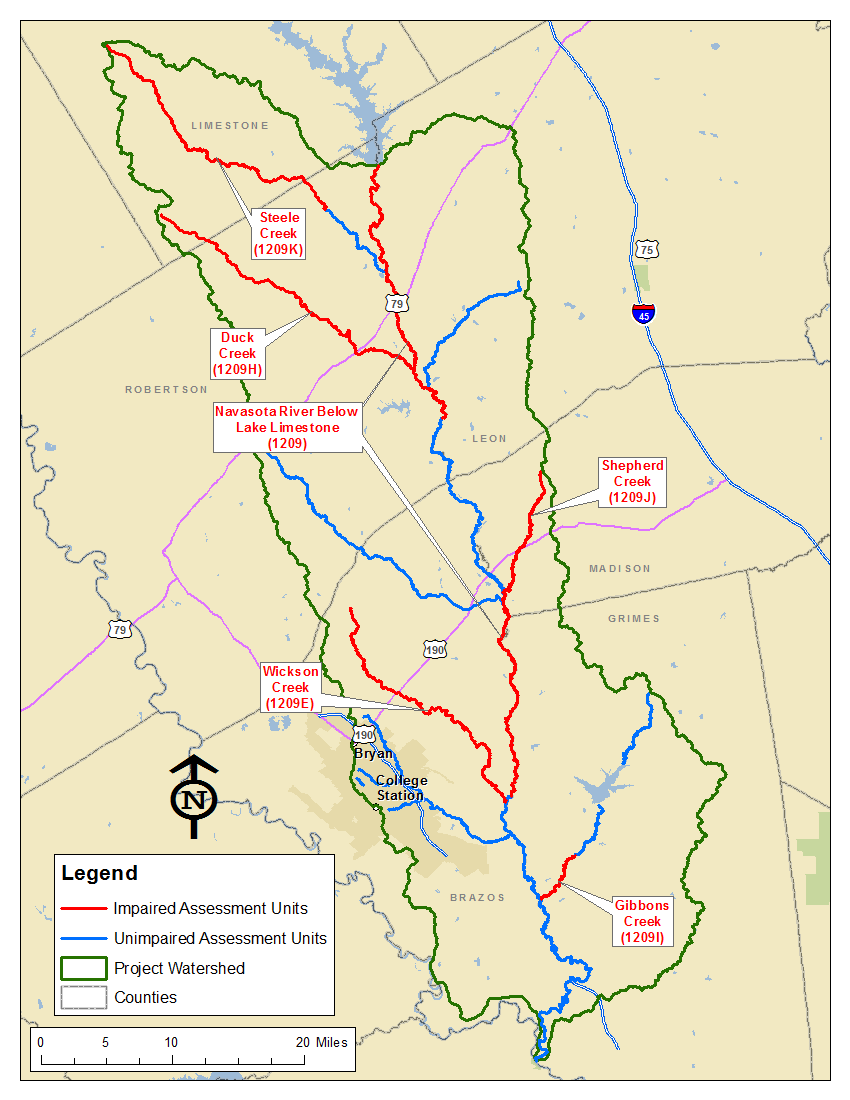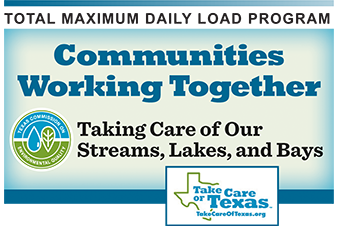Navasota River
Counties: Brazos, Grimes, Leon, Limestone, Madison, Robertson
Parameter: Bacteria
River Basin: Brazos
Segment: 1209
On this page:
- Background and Goal
- Watershed Description
- Get Involved
- I-Plan
- TMDLs
- Reports
- Contact the TMDL Program
Background and Goal
High concentrations of bacteria, which are found in both human and animal waste, have been observed in the river. The presence of these bacteria may indicate a health risk to people who swim or wade in the bayou — activities referred to as “contact recreation” in the Texas Surface Water Quality Standards.
The goal of this project is to improve water quality to protect recreational uses. Toward that goal, TCEQ and stakeholders have developed TMDLs and an I-Plan to reduce bacteria in the Navasota River.
Watershed Description
Segment 1209 of the Navasota River begins below Lake Limestone and flows until it connects with the Brazos River southwest of the town of Navasota. The watershed drains portions of Brazos, Grimes, Leon, Limestone, Madison, and Robertson counties in east-central Texas.
It is a predominately rural watershed that encompasses portions of the Northern Blackland Prairie, Southern Post Oak Savanna, San Antonio Prairie, and Flood Plains and Low Terraces. Much of the land cover in the watershed includes mixed forests and managed pastures or rangelands. Limited amounts of cropland and urban area exists in the watershed. The cities of Bryan and College Station are the largest urban areas.
Get Involved
Staff from the Texas Water Resources Institute worked with stakeholders to distribute information about this project and develop their plan. All public meetings about this project are open to anyone interested. Contact the TMDL Program about ways you could be involved.
I-Plan
Stakeholders in the watershed worked with TWRI and TCEQ to develop the I-Plan. The commission approved the I-Plan on August 28, 2019.
- Implementation Plan for Two Total Maximum Daily Loads for Indicator Bacteria in the Navasota River Below Lake Limestone
- Response to Comment on the I-Plan
Status of Activities
TCEQ provides opportunities for stakeholders to report on progress and changes in the watershed. Tracking of implementation progress allows stakeholders to evaluate actions taken, identify actions that may not be working, and make any changes as necessary.
- Year Three Implementation Status Update, June 2023
- Year Two Implementation Status Update, August 2022
- Year One Implementation Status Update, October 2020
TMDLs
The commission adopted these TMDLs on August 28, 2019. The EPA approved them on October 25, 2019, at which time they became part of the state's Water Quality Management Plan.
-
Two Total Maximum Daily Loads for Indicator Bacteria in the Navasota River Below Lake Limestone
Segment: 1209; Assessment Units: 1209_03 and 1209_05 - Response to Comment on the TMDLs
Revisions to TMDLs
From time to time, it is necessary to revise TMDLs to account for changing conditions in the watershed, such as new or amended permits, or urban growth, or to correct oversights in the original TMDL report. Revisions to the load allocations in TMDLs are made via the state’s WQMP, which is updated quarterly.
The WQMP provides projected effluent limits for use in planning and permitting activities under the Texas Pollutant Discharge Elimination System (TPDES). The TCEQ reviews all applications for new and amended permits for conformance with applicable portions of the WQMP, including adopted TMDLs.
Learn more about WQMP updates and about opportunities to comment on revisions to them.
Update
- January 2022, Appendix VII, pages 24-25
WQMP updates may be viewed in person at the TCEQ Library, Building A, 12100 Park 35 Circle, Austin, Texas. Electronic versions of updates published from 2014 through 2020 are available on the Texas State Library and Archives Commission website .
Reports
Contact the TMDL Program
Please email tmdl@tceq.texas.gov and mention the Navasota River in the subject line. Or call us at 512-239-6682.





 Back to top
Back to top